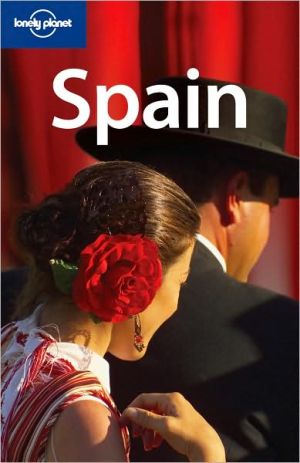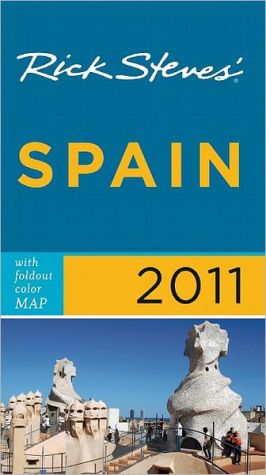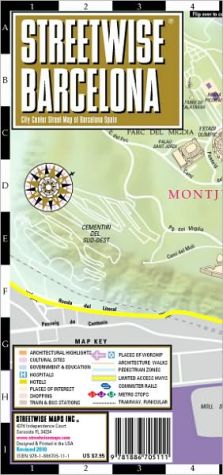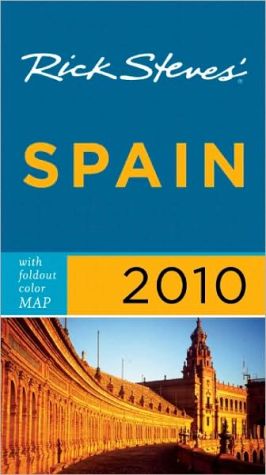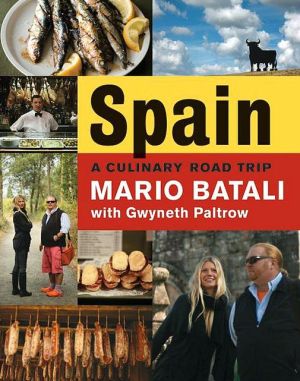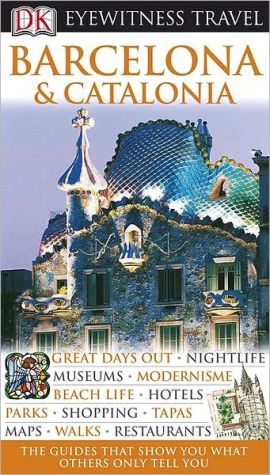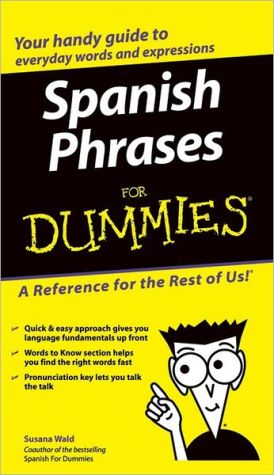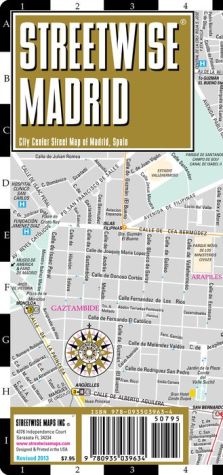Lonely Planet: Spain
Lonely Planet Spain\ Ascend the lofty La Sagrada Familia, then track down Gaudi's superb, lesser-known works Row vigorously over the lake at Madrid's Parque del Buen Retiro Relax with Basque tapas and white wine in the bars of San Sebastian's Parte Vieja Wander home to your casa rural as night falls and silence envelops the narrow village streets\ In This Guide:\ Nine authors, 4964 kilometers of coastline, 18 exuberant regions Full-color sections on green travel and the best of Spanish food...
Search in google:
Discover SpainAscend the lofty La Sagrada Familia, then track down Gaudi's superb, lesser-known works Row vigorously over the lake at Madrid's Parque del Buen Retiro Relax with Basque tapas and white wine in the bars of San Sebastian's Parte Vieja Wander home to your casa rural as night falls and silence envelops the narrow village streetsIn This Guide:Nine authors, 4964 kilometers of coastline, 18 exuberant regions Full-color sections on green travel and the best of Spanish food and drink Dedicated chapter on the Camino de Santiago by Galician resident and walking guide Nancy Frey Content updated daily: visit lonelyplanet.com
\ \ Chapter 1: History of Spain\ I-lie ancestors of today's Spaniards included Stone Arc hunters from Africa, Phoenicians, Visigoths from the Balkans, Berber tribes from Morocco, Jews and Arabs From the Middle Last, and numerous other European peoples. The ancestors of a good hall of the people of the Americas today - and others dotted across the rest of the globe were Spaniards. The key to thin ebb and Flw of peoples, cultures and empires is Spain', location: on both the Mediterranean Sea and the Atlantic Ocean, in Europe yet a stone's throw- from Africa and as near to America as am where in the Old World. I his pivotal position has entangled Spain in the affairs of half the world and half the world in Spain's. \ In the Beginning\ Caves throughout the country tell us plenty about Spain's earliest inhabitants. h he most impressive at Altamira near Santander, date From around 12,000 B('. Altamira's sophisticated. colourful paintings of bison, stag, boar and horses ,how confident brush strokes and realistic perspective not primitive efforts!\ Altamira was port of the Magdalenian hunting culture of southern trance and northern Spain, a Palaeolithic (Old Stone Age) culture that lasted from around 30,000 BC to the end of the Ice Age about 8000 BC. One of the maw theories about the origins of the Basque people of northern Spain and south-western France is that they are descended from the Magdalenians.\ But the story (OCS much further buck. In recent wars archaeologists hove discovered two lots of human bone fragments reckoned to be older than any others then d in Europe. Those found in 199-1 in the Sierra de Atapuerca near Burgos arc widely accepted to he about 780,000 years old and probably come from ancestors of the later Neanderthals. The second set of bones, from Orce near Granada and C'ueva Victoria in Murcia, are reckoned to be the remains of meals eaten by giant hyenas 1.2) to 1.6 million years ago, although some experts are sceptical that there were people in Spain so long ago. Front the later Neanderthal era comes 'Gibraltar Woman', a skull from about 50,000 BC, which was found in 1848. Current thinking is that the Neanderthals were displaced in about 10,000 BC, during the last Ice Age, by waves of migrants of African origin. File Cueva de Nerja in Andalucia is one of many Spanish sites of these Cro-Magrions, the first real modern humans, who hunted mammoth, bison and reindeer. Alter the Ice Age, new peoples known as Iberians or prate-Berbers arrived, probably from North Africa. Their rockshelter paintings of hunting and dancing survive on the cost coast.\ I he Neolithic (New Stone :age) reached eastern Spain from Mesopotamia and Egypt pt about 6000 BC, bringing innovations such as the plough. crops, livestock raising, pottery, textiles and permanent villages. Out of this arose, between 3000 and 2000 B(', the country's first metalworking culture, based at has Millares near Almeria.\ The Los Millares people's ability to smelt and shape local copper deposits was a big breakthrough in agricultural and military terms. l he same era also saw the building of megalithic tombs (dolmens), made of large rocks, in many parts of the Iberian peninsula's perimeter. l he best examples are at Antequera in Andalucia.\ l he next big technological advance was bronze - an alloy of copper and tin, and stronger than copper. About 1900 13C El Areal in Almeria province became probably the first Bronze Age settlement on the Iberian Peninsula.\ Celts\ From around 1000 to 500 BC, Celts (originally from Central Europe) and other tribes from beyond the Pyrenees started to settle north of the Rio Ebro. In contrast to the dark-leatured Iberians, the Celts were fair, drank beer and ate lard. The Celts and Iberians who merged on the peseta (the high tableland of central Spain) became the Celtiberians. Celts and Celtiberians typically lived in sizable hill fort towns called castvos. The Celts introduced iron technology to the north about the same time the Phoenicians brought it to the south.\ Phoenicians & Greeks\ By about 1000 BC there was a flourishing culture in the lower Guadalquivir valley in Andalucia. The development of this and other societies in the south and east was influenced by Phoenician and, later, Greek traders, who exchanged oils, textiles, jewels and ivory for local copper, silver and tin. The Phoenicians, a Semitic people from present-day Lebanon, set up permanent trading colonies including Cadiz (which they called Gadir), Huelva (Onuba), Malaga (Malaca) and Almunecar (Sexi). Cadiz's supposed founding date of 1100 BC may make it the oldest city in Europe. Greek settlements, which began around 600 BC, tended to be farther north on the Mediterranean coast. The main one was Emporion (Empuries), Catalunya.\ These incomers brought the potter's wheel, writing, coinage, some musical instruments, the olive tree and vine, and domestic animals like the donkey and hen. Around 700 B(. iron replaced bronze in the lower Guadalquivir valley. This Phoenician-influenced culture was very likely the fabled Iartessos, which later Greek, Roman and Biblical writers mythologised as a place of unimaginable wealth. No one knows whether Tartessos was a city or a state. If it was a city, it has vanished. Some believe it may lie beneath the delta of the Rio Guadalquivir.\ Carthaginians\ From about the 6th century BC the Phoenicians and Greeks were pushed out of the western Mediterranean by Carthage, a former Phoenician colony in modern Tunisia. Cadiz became the Carthaginians' main Iberian settlement, but there was a flourishing colony on Ibiza too.\ The Carthaginians came into conflict with the next rising Mediterranean powerRome. After losing the First Punic War (264-241 BC) fought against Rome for control of Sicily, Carthage responded by invading the Iberian peninsula under generals Hamilcar Barca, Hasdrubal and Hannibal. f he first landing was in 237 BC.\ The Second Punic War (218-201 BC) not only saw Hannibal march his elephants over the Alps towards Rome but also brought Roman legions to Spain to open up another theatre of war. Hannibal was eventually forced to retreat, finally being routed in North Africa in 202.\ Romans\ Though the Romans held sway on the peninsula for 600 years, it took them 200 years to subdue the fiercest of the local tribes.\ The Basques in the north, though defeated, were never Romanised like the rest of Hispania, as the Romans called the peninsula. Legendary stands against the Romans included the eight-year revolt led by the shepherd-turned-guerrilla Virathius in the west and centre from around 150 BC and the siege of Numancia near Soria in 133 BC. Rome had to bring in its most illustrious generals to deal with these and other insubordinations.\ By 50 AD most of the peninsula, particularly the south, had adopted the Roman way of life. This was the time of the Pax Romana, a long, prosperous period of stability. Hispanic became urbanised and highly organised- The early Roman provinces were called Hispanic Citerior and Hispanic Ulterior, with their capitals at Carthago Nova (Cartagena) and Cordoba (Cordoba), but in the Ist century BC they were reorganised into Baetica (most of present-day Andalucia plus southern Extremadura and south-western ('astilla-La Mancha), with its capital at Cordoba; Lusitania (Portugal and northern Extremadura), with its capital at Augusta Emerita (Merida), the greatest Roman city on the peninsula; and Tairacoriensis (the rest), with its capital at Tarraco (Tarragona).\ Rome gave the peninsula a road system, aqueducts, theatres, temples, amphitheatres, circuses, baths and the basis of its legal system and languages. The Roman era also brought many Jews, who spread throughout the Mediterranean part of the empire, and Christianity, which probably came with soldiers from North Africa and merchants in the 3rd century AD, taking root first in Andalucia. Hispanic gave Rome gold, silver, grain, wine, soldiers, emperors (Trajan, Hadrian and Theodosius) and even some of the greatest Latin literature-that of Seneca, Martial, Quintilian and Lucan. Another notable export was garum, a spicy sauce derived from fish and used as a seasoning. The finest of Spain's Roman ruins are at Empuries, Italica, Merida, Tarragona and Segovia.\ The Pax Romana started to crack when two Germanic tribes, the Franks and the Alemanni, swept across the Pyrenees in the late 3rd century AD, causing devastation. The end came when the Huns arrived in Eastern Europe from Asia a century later. Germanic people,, displaced by the Huns moved west, among them the Suevi and Vandals, who overran the Iberian Peninsula around 410 AD.\ Visigoths\ Another Germanic people, the Visigoths, sacked Rome itself in 410 AD. Within a few years, however, the Visigoths had become Roman allies, being granted lands in southern Gaul (France) and fighting on the emperor's behalf against other barbarian invaders nn the Iberian Peninsula. But in the 6th century the franks pushed the Visigoths out of Gaul. The Visigoths penetrated more deeply into the Iberian Peninsula and Toledo became their capital.\ The rule of the roughly ?00,000 longhaired Visigoths, who had a penchant for gaudy jewellery, over the several million more sophisticated Hispano-Romans was precarious and undermined by strife among their own nobility. The Hispano-Roman nobles still ran the fiscal system and their anachronistic bishops were the senior figures in urban centres. Town life declined in quality under Visigothic rule.\ Ties between the Visigoth monarchy and the Hispano-Romans were greatly strengthened in 587 AD, when King Recccred converted to orthodox Christianity from the Visigoths' Arian version which denied that Christ was identical with God. But the Visigoth kings still had to contend with regular revolts by nobles, bishops and others.\ The Visigoths had no long-standing culture of their own and tended to ape Roman ways. A few Visigothic churches can be seen today in northern Spain. One at Banns de Cerrato near Palencia, dating from 661, is probably the oldest church in the country.\ The Muslim Conquest\ By 700, with famine and disease in Toledo, strife among the aristocracy and chaos throughout the peninsula, the Visigothic kingdom was falling apart. This paved the way for the Muslim invasion of 711, which set Spain's destiny quite apart from that of the rest of Europe...
The Authors 18Getting Started 21Itineraries 24Snapshot 31History 33The Culture 53Architecture 71Environment 76Spain Outdoors 83Camino de Santiago 89Food & Drink 99Madrid 108History 109Orientation 109Information 110Dangers & Annoyances 111Sights 126Activities 138Walking Tours 139Courses 141Madrid for Children 142Tours 142Festivals & Events 143Sleeping 144Eating 148Drinking 154Entertainment 157Shopping 162Getting There & Away 164Getting Around 165Around Madrid 166San Lorenzo de El Escorial 166Valle de los Caidos 168South of Madrid 169Alcala de Henares 172Sierra de Guadarrama 173North of Madrid 174Castilla y Leon 175The Southwest 176Avila 176Sierra de Gredos 181Salamanca 183Around Salamanca 190Ciudad Rodrigo 191Sierra de Francia 192Sierra de Bejar 193The Central Plateau 194Segovia 194Around Segovia 199Valladolid 200Around Valladolid 204Zamora 206Around Zamora 209Palencia 209Around Palencia 211Montana Palentina 212The Northwest 212Leon 212East of Leon 218West of Leon 218The East 221Burgos 221Around Burgos 227North of Burgos 229South to Rio Duero 229West along Rio Duero 230East along Rio Duero 231Soria 233Around Soria 236South of Soria 236Castilla-La Mancha 238Toledo 239History 239Orientation 240Information 240Sights 240Walking Tour 246Courses 247Festivals & Events 247Sleeping 247Eating 248Drinking & Entertainment 248Shopping 249Getting There & Away 249Getting Around 249Around Toledo 250The West 250Talavera de la Reina 250Around Talavera de la Reina 250Montes de Toledo 251The South 251Ciudad Real 251Ciudad Real Province 252Southeast to Albacete 255Albacete 256Around Albacete 256The Northeast 257Cuenca 257Serrania de Cuenca 261Around Cuenca 262Guadalajara 262La Alcarria & Around 262Siguenza 263Around Siguenza 265Barcelona 266History 267Orientation 280Information 281Sights 283Activities 309Walking Tour 310Courses 311Barcelona for Children 311Tours 312Festivals & Events 312Sleeping 313Eating 318Drinking 323Entertainment 325Shopping 328Getting There & Away 330Getting Around 331Around Barcelona 333The Outskirts 333Sitges 334Montserrat 336Penedes Wine Country 338Catalonia 340Costa Brava 341Tossa de Mar 343Sant Feliu de Guixols 345Platja d'Aro & Palamos 346Palafrugell & Around 346Castell de Pubol 348Girona 349Verges 352Torroella de Montgri 352L'Estartit & the Illes Medes 353L'Escala 354Parc Natural dels Aiguamolls de L'Emporda 355Castello d'Empuries 355Roses & Around 355Cadaques & Around 356Cadaques to the French Border 358Figueres 358Besalu 361Around Figueres 361The Pyrenees 362Olot 362Parc Natural de la Zona Volcanica de la Garrotxa 363Ripoll 364Around Ripoll 365Vall Alto del Ter 366Vall de Nuria & Ribes de Freser 366Cerdanya 368Serra del Cadi 370La Seu d'Urgell 372Vall de la Noguera Pallaresa 373Northwestern Valleys 374Parc Nacional d'Aiguestortes i Estany de Sant Maurici & Around 375Val d'Aran 378Central Catalonia 381Vic 381Around Vic 382Manresa 382Cardona 382Solsona 382Conca de Barbera 383Lleida 384Montsec 386Costa Daurada 386Vilanova i la Geltru 386Altafulla 387Tarragona 387Port Aventura 392Reus & Around 392Cambrils 393Tortosa 393Ebro Delta 394Andorra 396Andorra la Vella 399Orientation 399Information 399Sights & Activities 400Sleeping 402Eating 402Drinking 403Entertainment 403Shopping 403Getting There & Around 403Around Andorra la Vella 403Northwestern Andorra 404La Massana 404Arinsal & Pal Ski Areas 404Ordino 405Vall d'Ordino 406Ordino-Arcalis Ski Area 406Eastern Andorra 407Encamp 407Grandvalira Ski Area 407Canillo 408Soldeu & El Tarter 408Pas de la Casa 409Andorra Directory 410Accommodation 410Activities 411Customs 411Dangers & Annoyances 411Embassies & Consulates 411Holidays 411Internet Resources 412Media 412Money 412Post 412Shopping 412Telephone 412Tourist Information 412Visas 412Aragon 413Zaragoza 415History 415Orientation 415Information 415Sights 416Festivals & Events 420Sleeping 420Eating 420Drinking 421Entertainment 422Getting There & Away 422Getting Around 423South of Zaragoza 423West of Zaragoza 423The North (The Pyrenees) 425Huesca 426Around Huesca 428Alquezar 428Barbastro & Around 429Benasque 430Around Benasque 431Ainsa 432Parque Nacional de Ordesa y Monte Perdido 433Jaca 437Around Jaca 439Valles de Echo & Anso 440Sos del Rey Catolico 441The South 442Daroca 442Laguna de Gallocanta 442Teruel 443Rincon de Ademuz 445Albarracin 445El Rodeno 446The Southeast 446Calanda 447Alcaniz 448Basque Country, Navarra & La Rioja 449Basque Country 451Bilbao 453Around Bilbao 461The Central Basque Coast 463San Sebastian 465East of San Sebastian 474South of San Sebastian 475Vitoria 476Navarra 479Pamplona 479East of Pamplona 485West of Pamplona 485North of Pamplona 487South of Pamplona 487The Pyrenees 488La Rioja 491Logrono 491Wine Region 494Monasteries West of Logrono 496South of Logrono 497Cantabria & Asturias 498Cantabria 499Santander 499Around Santander 505Eastern Cantabria 506Southern Cantabria 506Western Cantabria 507Asturias 512Oviedo 512Around Oviedo 517Gijon 517East Coast 521West Coast 524Picos de Europa 527Western Picos 530Central Picos 532Eastern Picos 535Galicia 538Santiago de Compostela 540History 541Orientation 541Information 541Sights 541Walking Tour 545Festivals & Events 545Sleeping 545Eating 546Drinking 548Entertainment 548Shopping 549Getting There & Away 549Getting Around 549A Coruna & the Rias Altas 549A Coruna 550Rias Altas 554Costa da Morte 558Malpica de Bergantinos 558Laxe, Camelle & Around 558Camarinas 559Muxia & Around 559Fisterra & Around 559Towards the Rias Baixas 560Rias Baixas 560Ria de Muros y Noia 560Ria de Arousa 561Pontevedra 562Ria de Pontevedra 565Ria de Vigo 566Vigo 566Illas Cies 569The Southwest 570The Coast 570Rio Mino 571The East 572Ourense 572Castelo de Monterrei 574Canon do Sil 574Monforte de Lemos 574Samos 575Lugo 575Valencia 577Valencia City 579History 579Orientation 579Information 579Sights & Activities 581Walking Tour 585Courses 586Valencia for Children 586Tours 587Festivals & Events 587Sleeping 587Eating 588Entertainment 590Getting There & Away 592Getting Around 592Around Valencia City 593Costa del Azahar 595Castellon de la Plana 595Around Castellon de la Plana 596Benicassim 596Oropesa del Mar 605Peniscola 606Vinaros 607El Maestrazgo 607Sant Mateu 607Morella 608Els Ports 609Costa Blanca 609Gandia 610Denia 611Xabia 611Calpe 612Altea 613Benidorm 613Alicante 616Around Alicante 620Torrevieja 620Inland from the Costa Blanca 621Xativa 621Villena 622Elda 622Novelda 622Jijona 623Alcoy 623Guadalest 623Elche 623Orihuela 625Balearic Islands 627History 628Getting There & Around 628Mallorca 630Palma de Mallorca 632Southwest Coast 637Northwest Coast & Serra de Tramuntana 638Badia d'Alcudia 642East Coast 643The Interior 644Ibiza (Eivissa) 645Ibiza City (Eivissa) 647East Coast 652North Coast & Interior 654West Coast 655South Coast 656Formentera 656Menorca 661Mao 663The Interior-Mao to Ciutadella 666Ciutadella 666North Coast 670South Coast 671Murcia 672Murcia City 673Orientation 673Information 673Sights 674Festivals & Events 675Sleeping 675Eating 676Drinking & Entertainment 676Shopping 676Getting There & Away 676Getting Around 677Murcia Region 677Cartagena 677Costa Calida 680Lorca 681Parque Natural de Sierra Espuna 682Andalucia 683Seville 686History 686Orientation 687Information 690Sights 690Walking Tour 699Courses 700Seville for Children 700Tours 700Festivals & Events 700Sleeping 701Eating 703Drinking 704Entertainment 705Shopping 706Getting There & Away 706Getting Around 707Around Seville 708Carmona 708Osuna 709Huelva Province 709Huelva 709Lugares Colombinos 710Parque Nacional de Donana 711West of Huelva 713Minas de Riotinto 714Aracena 715West of Aracena 715Cadiz Province 716Cadiz 716El Puerto de Santa Maria 721Sanlucar de Barrameda 722Jerez de la Frontera 724Arcos de la Frontera 728Parque Natural Sierra de Grazalema 729Southern Costa de la Luz 731Tarifa 733Algeciras 737La Linea de la Concepcion 739Gibraltar 739Malaga Province 743Malaga 743Costa del Sol 749El Chorro & Bobastro 754Ronda 755Around Ronda 758Antequera 758Around Antequera 759East of Malaga 760Cordoba Province 761Cordoba 761Around Cordoba 768Granada Province 768Granada 768Around Granada 783Guadix 783Sierra Nevada 783The Coast 789Jaen Province 790Jaen 790Baeza 793Ubeda 794Cazorla 796Parque Natural de Cazorla 796Almeria Province 799Almeria 799Around Almeria 803Cabo de Gata 803Mojacar 806Extremadura 808Northern Extremadura 809La Vera 809Valle del Jerte 812Valle del Ambroz 813Las Hurdes 814Sierra de Gata 816Coria & Around 816Plasencia 817Parque Nacional Monfrague 818Central Extremadura 819Caceres 819Valencia de Alcantara 823Alcantara 823Trujillo 824Guadalupe 827Southern Extremadura 829Merida 829Badajoz 833Around Badajoz 835Zafra 836Around Zafra 836Directory 838Accommodation 838Business Hours 842Children 842Climate Charts 843Courses 844Customs 845Dangers & Annoyances 845Discount Cards 846Embassies & Consulates 846Festivals & Events 847Food 848Gay & Lesbian Travellers 849Holidays 849Insurance 850Internet Access 850Legal Matters 850Maps 851Money 851Post 852Shopping 853Solo Travellers 854Telephone 854Time 855Tourist Information 855Travellers with Disabilities 856Visas 856Volunteering 857Women Travellers 857Work 857Transport 859Getting There & Away 859Entering The Country 859Air 859Land 863Sea 866Getting Around 867Air 867Bicycle 867Boat 868Bus 868Car & Motorcycle 869Hitching 870Local Transport 870Train 872Health 874Before You Go 874Insurance 874Recommended Vaccinations 874Internet Resources 874In Transit 874Deep Vein Thrombosis (DVT) 874In Spain Availability & Cost of Health Care 875Traveller's Diarrhoea 875Environmental Hazards 875Travelling With Children 876Women's Health 876Sexual Health 876Language 877Glossary 884Behind the Scenes 889Index 896World Time Zones 914Map Legend 916Metro Maps 917
